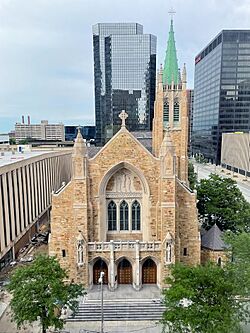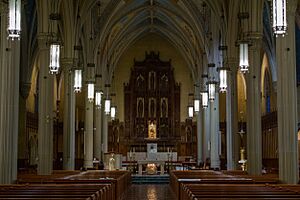Cathedral of St. John the Evangelist (Cleveland) facts for kids
Quick facts for kids Cathedral of St. John the Evangelist |
|
|---|---|

Cathedral of St. John the Evangelist
|
|
| Location | 1007 Superior Avenue, Cleveland, Ohio 44115 |
| Country | United States |
| Denomination | Roman Catholic |
| Architecture | |
| Architect(s) | Patrick Keely (1852), Stickle and Associates (1946–48) |
| Years built | 1852 |
| Administration | |
| Diocese | Cleveland |
The Cathedral of St. John the Evangelist, often called St. John's Cathedral, is a very old and important Roman Catholic church. You can find it in Cleveland, Ohio, in the United States. This beautiful church was finished and officially opened in 1852. It serves as the main church, or cathedral, for the Roman Catholic Diocese of Cleveland. Over the years, the cathedral has been updated and made bigger. Even with these changes, it still looks much like it did when it was first built.
Contents
History of St. John's Cathedral
Many Catholic families started moving to the Western Reserve area of Ohio in the 1830s. Priests from the Archdiocese of Cincinnati would visit them to hold church services. In 1826, a small group of Irish settlers started their own church called St. Mary's of the Flats. They met in different places before they began building their own church in 1837.
Building the First Cathedral
In 1847, Pope Pius IX created the Catholic Diocese of Cleveland. He chose Louis Amadeus Rappe to be its first bishop. Bishop Rappe decided to build St. John's Cathedral on land that was bought in 1845. This land was located on Superior Street and Erie Street, which is now East 9th Street.
The bishop chose Patrick Keely as the architect. Keely designed the church in a fancy gothic style. Bishop Rappe laid the first stone of the new church on October 22, 1848. While the new building was being constructed, St. Mary's church served as the main church for the diocese. When the new cathedral was finished in 1852, it was quite far from Cleveland's Public Square.
Early Changes and Growth
Changes and additions to the church began soon after it was built. In 1857, a school for boys was added. Within ten years, a church hall and a girls' school were also built. In 1879, the church raised enough money to decorate the inside and outside of the building. They also added a tall spire to the top. To pay for the first building, Bishop Rappe had to ask for donations from places as far away as New York City and France.
In 1884, the inside of the church was redecorated. New stained glass windows were put in, along with wooden furniture in the main worship area. The windows were changed again in 1902. These new windows were beautiful art glass windows from Munich, Germany.
A Famous Funeral at the Cathedral
On August 20, 1920, a very large funeral took place at the cathedral. It was for a famous baseball player named Ray Chapman. Thousands of people gathered inside and around the cathedral. It was one of the biggest funerals ever held in Cleveland. Ray Chapman was a popular player who had died just days before. He was hit in the head by a baseball during a game. He is still the only player to have died from an injury during a Major League baseball game.
Major Renovations in the 1940s
In 1943, Archbishop Joseph Schrembs announced a plan to update the cathedral. However, because of World War II, the plan was put on hold until 1945. After the war, Archbishop Edward Francis Hoban, who took over from Schrembs, continued the plan. Construction started in 1946. The old cathedral was made bigger, and its brick outside was covered with orange Tennessee Crab Ochard Sandstone.
The architectural company Stickle, Kelly and Stickle managed the construction. This work also included building a new bell tower and decorating the inside. However, the tower did not have any bells until 1988. John W. Winterich and Associates oversaw the creation of a new reredos (a screen or decoration behind the altar) and other inside decorations. Today, the cathedral can seat about 1,500 people for services.
The updated cathedral included several new chapels. One of these was the Resurrection Chapel. This chapel holds the tombs of past bishops. It also holds the relics of St. Christine of Calixtus. Her relics were found in the Catacombs of St. Calixtus near Rome. Pope Pius XI gave them to Archbishop Schrembs in 1925. Records show that Christine was a girl of about 13 or 14. She died for her faith around the year 300. It was a tradition then to bury martyrs with a small glass bottle of their blood. This showed they had given their life for their faith.
The church still uses the large organ that was put in during this renovation. It has 4,368 pipes and 72 different sounds. The Holtkamp Organ Company of Cleveland built it. The organ can be played from a console in the loft or from another one behind the bishop's chair. On September 4, 1948, Archbishop Hoban and Cardinal Francis Spellman from New York City held a special Mass. This celebrated the completion of the renovation of St. John's Cathedral.
Later Changes and Additions
The renovation also added a building for St. John's College. Later, St. John's College joined with Ursuline College. The college building was then taken down to build the Eaton Center in 1981. In 1964, St. John's added a dormitory tower. This tower was later changed to hold offices for the diocese. In 2007, the diocese moved its offices. The tower was then taken down to create a parking lot for the growing Avenue District. A parking garage was built nearby for churchgoers.
In 1977, Bishop James Hickey made more changes to the cathedral. These changes were made because of new rules from Vatican II. The altar was moved from the back of the church to its current spot in the middle. This is close to where the altar of the very first cathedral stood.
In 1988, church members raised money to put bells in the tower. This tower was added during the 1946–1948 renovation. There are six bells, and they weigh from about 170 kilograms (375 pounds) to 1,500 kilograms (3,300 pounds). They are named after saints and important people in US history. The bells first rang to celebrate Christmas Masses in 1988.
In 1996, the Italian American community in Cleveland helped pay to update the sacristy. This was to celebrate Bishop Anthony Pilla being chosen as President of the United States Conference of Catholic Bishops in 1995. In 1997, the diocese celebrated its 150th birthday. That year, ABC-TV made a special show about the cathedral. Bishop Pilla opened a Holy Door in 2000 as part of a special Holy Year announced by Pope John Paul II. In 2002, the cathedral fixed its flagpole. They rededicated it on September 11, 2002, one year after the attacks of September 11, 2001.
Recent Bishops
In 2006, Bishop Pilla retired. Pope Benedict XVI then named Bishop Richard Lennon from Boston as the 10th Bishop of Cleveland. In November 2016, Bishop Lennon asked Pope Francis if he could retire early because of his health. On December 28, 2016, Pope Francis accepted his retirement. On the same day, Pope Francis named Daniel Edward Thomas, who was the Bishop of the Diocese of Toledo, to temporarily lead the Cleveland diocese.
On July 11, 2017, Pope Francis named Nelson Jesus Perez as the 11th Bishop of the Diocese of Cleveland. He was officially welcomed as Bishop on September 5, 2017. Three years later, after Bishop Perez became Archbishop of Philadelphia, Pope Francis named Edward C. Malesic as the current Bishop of Cleveland.
See also
 In Spanish: Catedral de San Juan Evangelista (Cleveland) para niños
In Spanish: Catedral de San Juan Evangelista (Cleveland) para niños
- List of churches in the Roman Catholic Diocese of Cleveland
- List of Catholic cathedrals in the United States
- List of cathedrals in the United States


